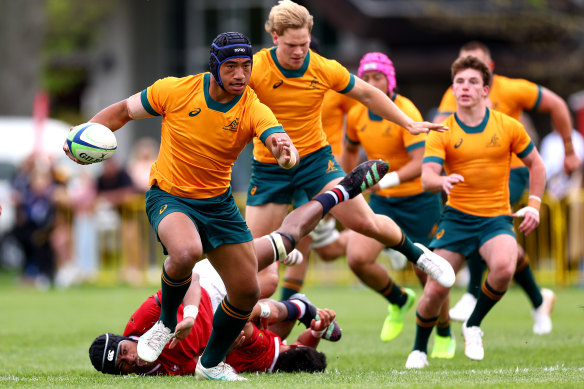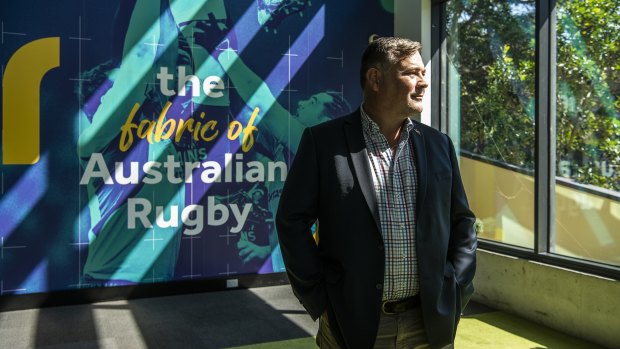Opinion
Australia are turning Irish – and a bit of green suits them
Paul Cully
Rugby columnistBit by bit, Rugby Australia’s plan for restoring the game is becoming apparent.
The plan isn’t Joseph-Aukuso Suaalii. Throwing millions at one bloke – who needs to bulk up by about eight kilograms judging by this week’s new jersey photoshoot – and hoping that he solves everything is certainly must-watch sporting theatre.
But the real plan has been partly revealed by the under-16s and under-19s Super Rugby comps that have been running – with some investment given the travel costs involved – and the bigger picture that everything in Australian rugby is now going to go through the four remaining Super franchises, two of which have been “centralised” by RA.
RA high performance guru Peter Horne said: “We’ve made a big push pivoting a bit into under-14s and having a connection at under-14s and 15s, and those players in our system from 14 through to just over 20, we’ve been able to retain a significant proportion.”
The absolute magic ingredient here isn’t just the age of the player, it’s the alignment with the Super Rugby teams and the idea that a 15-year-old is connected to the Waratahs or Reds right through until he or she makes their debut at 22 or 23.

Australian Schools stars Heinz Lemoto will be the subject of cross-code lobbying.Credit: Getty Images for Rugby Australia
Let’s call this the “one-page plan” – in that the Super Rugby franchise can sit in front of a talented 15-year-old and their parents and simply articulate on one A4 piece of paper how they will go from school into a Wallabies jersey and play in front of 80,000 at Twickenham.
It’s that simplicity that’s key, and don’t take it for granted.
In fact, I have borrowed that “one-page” language from New Zealand Rugby, which is trying to streamline its pathway, which is for one reason or another, not as clean as the one RA is putting together.
A player in, say, Taranaki might go into a provincial academy, then the National Provincial Championship (NPC), then the Chiefs Super Rugby side. In addition, he might then be picked for the Chiefs, but overlooked for his province when he goes back to the NPC.
This isn’t uncommon, and as much as Australians look at the NPC with envy, chairs and chief executives at provincial and Super level across the ditch told the Herald earlier this year that there was duplication and disconnection in their system.
Australia, therefore, has been right to fashion a system that suits its own needs rather than mimic New Zealand, and it is starting to look a lot more like the Irish system.
The outcomes from this, of course, will depend on the quality of people involved, but the rewards are quite obvious. The “Leinsterfication″ of Australian rugby would have a profound effect on the success of the Wallabies and the Super Rugby teams, and the Waratahs would seem to be the team with the most to gain.
I watched the Leinster team sheet closely in the opening three rounds of the United Rugby Championship, which began last month. I barely knew a lot of the names, yet when I actually watched them play they were like mini-me versions of the established Irish internationals who were gradually being reintroduced.

RA’s director of high performance, Peter Horne, is changing things up.Credit: Steven Siewert
The Leinster system or pattern of play didn’t change – or the required skill levels – because the new blokes coming in had obviously been embedded in the system for years before the rest of the world saw them (and they won all three URC games).
Granted, the wealthy Dublin schools do a lot of heavy lifting for Leinster, but something similar is happening in NSW and Queensland judging by the Australia under-18s’ win against New Zealand Schools last month.
There’s no instant gratification in this RA strategy – it’s the anti-Suaallii model – but methodical planning and execution is clearly the new black at RA.
If they do get it right, the benefits will be various and significant, but no more needs to be said than New Zealand teams have struggled for years when confronted with teams with genuine structure and purpose that won’t let them turn games into a one-v-one talent contest.
No strategy is without its challenges. For example, there might not actually be a high conversion rate of the under-16s going through to full-time professional ranks.
There might only be two or three each year who actually kick on into the professional ranks, but that won’t discredit the plan. During a 10-year period that means an entire Waratahs or Reds 23 could come through the same system.
It might be galling to think that’s how long it’ll take for Australian rugby to rebuild, but RA chief executive Phil Waugh and chairman Daniel Herbert are young men, and Australian rugby should cross their fingers that they survive the politics long enough to see this through.